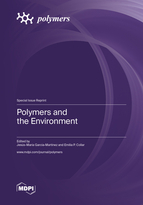Polymers and the Environment
A special issue of Polymers (ISSN 2073-4360). This special issue belongs to the section "Circular and Green Polymer Science".
Deadline for manuscript submissions: closed (15 December 2022) | Viewed by 23626
Special Issue Editors
Interests: polymers and environment; heterogeneous materials based on polymers; polyolefins; interfacial agents; interphase; interface; functionalization; plastic wastes; blends; composites
Special Issues, Collections and Topics in MDPI journals
Interests: polymers and environment; heterogeneous materials based on polymers; polyolefins; interfacial agents; interphase; interface; functionalization; plastic wastes; blends; composites
Special Issues, Collections and Topics in MDPI journals
Special Issue Information
Dear Colleagues,
In the early 1980s, the first global environmental crisis took place with an emphasis on the role played by the presence of plastics in the huge solid waste streams of big cities. It was clear then (and now) that the best environmental management practices required solid scientific and technical knowledge (most times under technical standards). Thus, these plastics, once at the end of their useful life, now have their materials (polymers and additives) coalesced into a circular economy strategy conjugated with the non-steady scenarios of the other key sectors of the economy, industry, society, and policy. Thus, a twofold perspective, applied and academic, to link tandem polymers and the environment has led, forty years later, to a wide polymer research field devoted to the continuous improvement of the environmental performance of polymer and polymer-based materials. This strategy comprises all the steps in the polymer management chain, from the raw materials to the polymers themselves, many of which come from classical and/or renewable sources (so-called bioplastics). There is this a need to improve the processability, ultimate properties, and performance through friendly environment additives; the recyclability of the materials; and innovative processes that will allow for better mechanical and/or energy recovery, including chemical recycling. Therefore, this Special Issue welcomes all works related to this frontrunner polymer R&D area.
Dr. Jesús-María García-Martínez
Dr. Emilia P. Collar
Guest Editors
Manuscript Submission Information
Manuscripts should be submitted online at www.mdpi.com by registering and logging in to this website. Once you are registered, click here to go to the submission form. Manuscripts can be submitted until the deadline. All submissions that pass pre-check are peer-reviewed. Accepted papers will be published continuously in the journal (as soon as accepted) and will be listed together on the special issue website. Research articles, review articles as well as short communications are invited. For planned papers, a title and short abstract (about 100 words) can be sent to the Editorial Office for announcement on this website.
Submitted manuscripts should not have been published previously, nor be under consideration for publication elsewhere (except conference proceedings papers). All manuscripts are thoroughly refereed through a single-blind peer-review process. A guide for authors and other relevant information for submission of manuscripts is available on the Instructions for Authors page. Polymers is an international peer-reviewed open access semimonthly journal published by MDPI.
Please visit the Instructions for Authors page before submitting a manuscript. The Article Processing Charge (APC) for publication in this open access journal is 2700 CHF (Swiss Francs). Submitted papers should be well formatted and use good English. Authors may use MDPI's English editing service prior to publication or during author revisions.
Keywords
- plastics and circular economy
- bioplastics
- biocomposites
- ecofriendly blends
- additives and plastics performance
- ecofriendly additives
- plastic wastes and recycling
- plastic wastes valorization routes
- Life Cycle Assessment (LCA)
- standardization and legal frameworks







